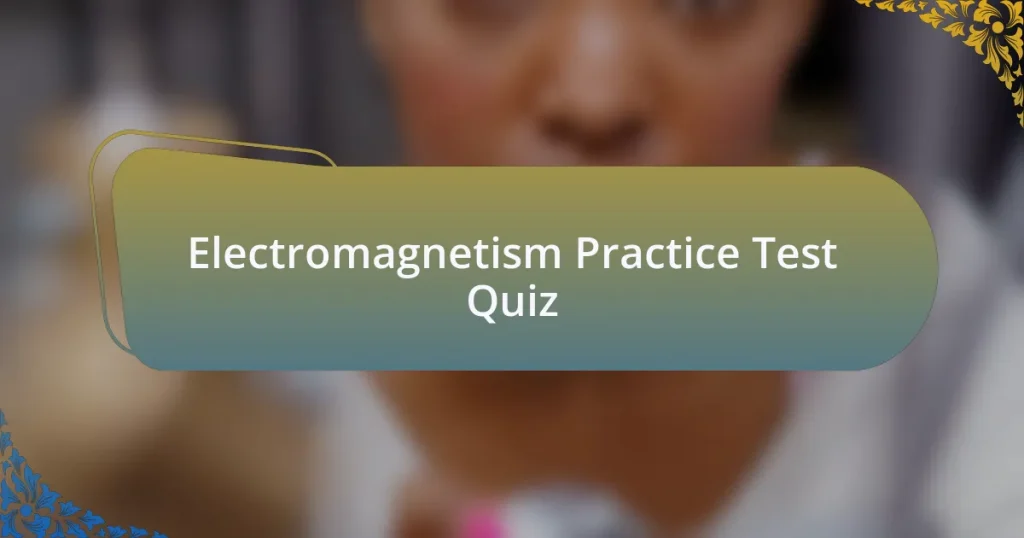Start of Electromagnetism Practice Test Quiz
1. What is an electric field?
- An area where magnets can attract without contact.
- A region around a charged particle or object where the force due to the electric field can be detected.
- A measure of how much energy is produced by a current.
- The speed at which light travels in a vacuum.
2. What are the main differences between an electric field and a magnetic field?
- Electric fields can originate only from magnets, whereas magnetic fields come from electric charges.
- Electric fields are created by magnetic fields, and magnetic fields have no influence on electric fields.
- Electric fields only affect positive charges, while magnetic fields affect negative charges.
- Electric fields are produced by stationary charges, while magnetic fields are produced by moving charges or changing electric fields.
3. What is a north pole in the context of magnetism?
- A point on a magnet where electrical current flows.
- A point on a magnet where the magnetic field lines emerge.
- A device that stores magnetic energy.
- A mechanism used to generate electric energy.
4. What does a south pole refer to on a magnet?
- A point on a magnet that generates electricity.
- A point on a magnet where the magnetic field lines enter.
- A point on a magnet that repels other magnets.
- A point on a magnet where the magnetic field lines cross.
5. Can you name some examples of electromagnetic radiation?
- Mechanical waves, seismic waves, and thermal radiation
- Nuclear waves, magnetic waves, and electron waves
- Sound waves, microwaves, and infrared
- Light, radio waves, X-rays, and gamma rays
6. How does a compass needle react when placed near a magnet?
- A compass needle turns randomly without any direction.
- A compass needle aligns itself with the magnetic field lines of the magnet.
- A compass needle repels from the magnet with force.
- A compass needle remains stationary and doesn`t react to the magnet.
7. What occurs when a wire conducts an electric current?
- The wire expands and contracts rapidly.
- A magnetic field is generated around the wire.
- The wire becomes electrically charged permanently.
- The wire emits light due to heat.
8. What does Faraday’s Law of Induction state?
- A constant magnetic field has no effect on an electric field.
- Electric fields create magnetic monopoles.
- An electric current generates an unchanging magnetic field.
- A varying magnetic field induces an electric field.
9. What is described by Ampère’s Law?
- A magnetic field generates an electric current.
- An electric current generates a magnetic field.
- An electric field generates a magnetic charge.
- A magnetic charge generates an electric field.
10. What does Gauss’s Law for magnetism indicate about magnetic charges?
- Magnetic charges can exist in isolation like electric charges.
- Gauss`s Law states that magnetic charges can be created and destroyed.
- There are no isolated magnetic charges; magnetic monopoles do not exist.
- Gauss`s Law implies that magnetic charges repel each other.
11. How does Earth`s magnetic field influence a compass reading?
- A compass needle floats freely in water since it’s non-magnetic.
- A compass needle only moves in response to electric currents.
- A compass needle always points directly south regardless of magnetic fields.
- A compass needle points towards Earth’s magnetic North Pole.
12. In a magnetic field, how is the force on a current-carrying wire directed?
- In the same direction as the current flow.
- Perpendicular to both the current direction and the magnetic field direction.
- Opposite to the magnetic field direction.
- Parallel to the magnetic field direction.
13. What is the function of a transformer?
- To store electrical energy in batteries.
- To transfer electrical energy from one circuit to another through electromagnetic induction.
- To convert electrical energy into kinetic energy directly.
- To increase the temperature of an electric circuit.
14. Define an electromagnetic wave.
- A wave that only involves electric fields moving through a vacuum.
- A wave that propagates through a medium or through space and is characterized by both electric and magnetic field components.
- A phenomenon that exclusively describes static electric charges.
- A disturbance in a solid that travels due to particle vibrations.
15. What distinguishes a conductor from an insulator regarding electromagnetic fields?
- Conductors allow electric currents and generate magnetic fields.
- Insulators allow electric currents to generate magnetic fields.
- Insulators generate magnetic fields and allow electric currents to flow.
- Conductors do not allow electric currents and do not generate magnetic fields.
16. How does a magnet produce an electric current in a coil?
- By increasing the size of the coil to enhance the existing magnetic field, increasing the current flow.
- By changing the magnetic field around the coil, inducing an electromotive force (EMF) that drives an electric current.
- By rotating the coil within a stationary magnetic field, creating friction that generates electric charge.
- By applying a constant magnetic field to the coil, producing heat that generates current.
17. What principle underlies electromagnetic induction?
- The principle that a changing magnetic field induces an electric field.
- The principle that electric fields can repel each other.
- The principle that magnets can create static electricity.
- The principle that electric currents always flow through insulators.
18. What is an ammeter used for in electrical circuits?
- To measure the voltage across a circuit.
- To regulate the charge in a battery.
- To measure the resistance in a circuit.
- To measure the current flowing through a circuit.
19. What happens to a solenoid when an electric current is applied?
- It heats up and melts.
- It acts as a magnet with a north and south pole.
- It repels all nearby objects.
- It emits light and sound.
20. How do Maxwell’s equations relate electric and magnetic fields?
- Maxwell’s equations state that electric fields are completely independent of magnetic fields.
- Maxwell’s equations only describe electric fields and do not involve magnetism.
- Maxwell’s equations explain how electric charges can exist in isolation without any magnetic effect.
- Maxwell’s equations show how electric and magnetic fields are produced and changed by each other.
21. What is the correlation between frequency and wavelength in electromagnetic waves?
- The frequency of an electromagnetic wave is inversely proportional to its wavelength.
- The frequency and wavelength of electromagnetic waves are unrelated.
- The frequency of an electromagnetic wave decreases with increasing speed.
- The frequency of an electromagnetic wave is directly proportional to its wavelength.
22. How do magnetic fields affect charged particles?
- Charged particles do not interact with magnetic fields at all, remaining unaffected.
- Charged particles are attracted directly towards magnetic poles without any other forces involved.
- Magnetic fields only repel charged particles, causing them to move away.
- Charged particles experience a force perpendicular to both their velocity and the magnetic field direction.
23. What purpose does a Faraday shield serve in electromagnetic applications?
- To generate electrical power from magnetic fields.
- To block electromagnetic radiation by absorbing or reflecting it.
- To store electrical energy for future use.
- To amplify electromagnetic signals for better transmission.
24. Compare static and dynamic electricity.
- Static electricity generates magnetic fields, whereas dynamic electricity does not involve any charges.
- Static electricity only appears in batteries, while dynamic electricity occurs in capacitors.
- Static electricity involves stationary charges, while dynamic electricity involves moving charges.
- Static electricity refers to movement of particles in a conductor, while dynamic electricity refers to magnetic fields.
25. In what way does Earth`s magnetic field safeguard life on the planet?
- It increases the temperature of the atmosphere.
- It shields life from harmful solar and cosmic radiation.
- It absorbs all radiation coming from space.
- It reflects harmful weather patterns away from the planet.
26. How is electromagnetic induction observed in everyday devices?
- It is a process related to gravitational fields only.
- It is used in devices like generators, transformers, and motors.
- It is responsible for the formation of chemical bonds in materials.
- It primarily occurs during nuclear reactions.
27. What is the relationship between electric current and magnetic field strength?
- The strength of the magnetic field is proportional to the current flowing through the wire.
- The magnetic field weakens as the current increases.
- The strength of the magnetic field decreases with increasing current levels.
- The magnetic field and current have no relationship at all.
28. Describe how magnets interact with one another.
- Magnets attract or repel each other based on their poles.
- Magnets only attract each other regardless of their orientation.
- Magnets do not affect each other and are always neutral.
- Magnets interact by generating electric fields that push them apart.
29. What role does an electromagnet play in industrial uses?
- To measure weight in scales.
- To generate electricity in a power plant.
- To provide a strong magnetic field for lifting heavy objects or moving parts.
- To cool down machinery in operations.
30. How do electromagnetic waves convey energy?
- Electromagnetic waves carry energy by propagating sound waves.
- Electromagnetic waves transfer energy through oscillating electric and magnetic fields.
- Electromagnetic waves convey energy via gravitational interactions.
- Electromagnetic waves transmit energy solely through mechanical vibrations.
Quiz Successfully Completed!
Congratulations on completing the Electromagnetism Practice Test! Engaging with this material not only enhances your understanding of electromagnetism but also strengthens your problem-solving skills in physics. You may have discovered key concepts such as electric fields, magnetic forces, and electromagnetic induction. Each question provided an opportunity to deepen your knowledge and tackle common misconceptions.
Throughout the quiz, you likely reinforced your grasp of important formulas and principles. Remember, electromagnetism is fundamental to many technological applications we encounter every day. From electric motors to magnetic resonance imaging, the applications of this field are vast and impactful. Reflection on your results can also guide your future study sessions, revealing areas that need more focus and practice.
We invite you to explore the next section dedicated to Electromagnetism on this page. You’ll find additional resources, in-depth explanations, and practice questions to further enrich your understanding. Whether you are preparing for an exam or simply curious about the physical world, delving deeper into electromagnetism will undoubtedly broaden your knowledge. Happy studying!
Electromagnetism Practice Test
Understanding Electromagnetism: Basics and Importance
Electromagnetism is a fundamental branch of physics that studies the interactions between electric charges and magnetic fields. It combines electricity and magnetism into a single framework, described by Maxwell’s equations. Understanding electromagnetism is crucial because it underpins many modern technologies, such as electronics, telecommunications, and power generation. Mastery of these concepts is essential for students preparing for exams in physics, as it forms the core of many advanced topics in both classical and modern physics.
Key Concepts in Electromagnetism for Test Preparation
Test preparation in electromagnetism focuses on several key concepts, including electric fields, magnetic fields, electromagnetic induction, and electromagnetic waves. Students should be familiar with Coulomb’s Law, the Biot-Savart Law, and Faraday’s Law of Induction. Mastering these concepts allows students to solve problems related to circuit behavior, magnetic forces on moving charges, and wave propagation. Deep understanding in these areas is often tested through problem-solving in practice tests.
Types of Electro-Magnetic Problems Common in Practice Tests
Practice tests typically feature various types of problems, such as calculation of electric field strength, determination of magnetic field around a current-carrying wire, and application of Lenz’s law in induction problems. Students may encounter multiple-choice questions, numerical problems, and conceptual questions. Understanding how to approach each type is vital for effective test performance.
Effective Study Strategies for Electromagnetism Practice Tests
To effectively prepare for electromagnetism practice tests, students should employ targeted study strategies. These include engaging with problem sets, utilizing flashcards for key formulas and concepts, and collaborating in study groups. Additionally, online resources, such as interactive simulations, can help visualize abstract concepts. Timed practice tests can also improve time management skills during actual exam conditions.
Reviewing Common Mistakes in Electromagnetism Tests
Common mistakes in electromagnetism tests often include miscalculating vector quantities, misunderstanding the direction of electromagnetic forces, and neglecting units. Students often confuse the right-hand rule applications or overlook significant details in problems. Reviewing these common pitfalls enhances understanding and helps students avoid similar errors in practice tests, ultimately leading to improved scores.
What is an Electromagnetism Practice Test?
An Electromagnetism Practice Test is a standardized assessment designed to evaluate a student’s understanding of electromagnetism concepts in physics. This test typically includes questions on electric fields, magnetic fields, electromagnetic waves, and their interactions. It aims to prepare students for exams by reinforcing key principles and problem-solving techniques associated with the electromagnetic force, as outlined in physics curricula.
How do you prepare for an Electromagnetism Practice Test?
Where can you find Electromagnetism Practice Tests?
Electromagnetism Practice Tests can be found in various places, including educational websites, high school and college physics department resources, and test preparation books. Websites like Khan Academy and Quizlet offer practice questions and tests specifically for electromagnetism. Libraries and bookstores often carry study guides that feature practice tests on this topic.
When should you take an Electromagnetism Practice Test?
Students should take an Electromagnetism Practice Test after thoroughly studying the subject material but before the actual exam date. Taking the test a few weeks prior allows for assessment of knowledge retention and identification of weaker areas. This timing helps maximize learning and provides an opportunity for targeted review before the final exam.
Who should take an Electromagnetism Practice Test?
High school and college students enrolled in physics courses should take an Electromagnetism Practice Test. This test is particularly beneficial for those preparing for standardized exams such as the SAT Subject Tests or Advanced Placement (AP) Physics exams. Additionally, students who are pursuing engineering or physical sciences will find these tests useful for solidifying their foundational knowledge in electromagnetism.















